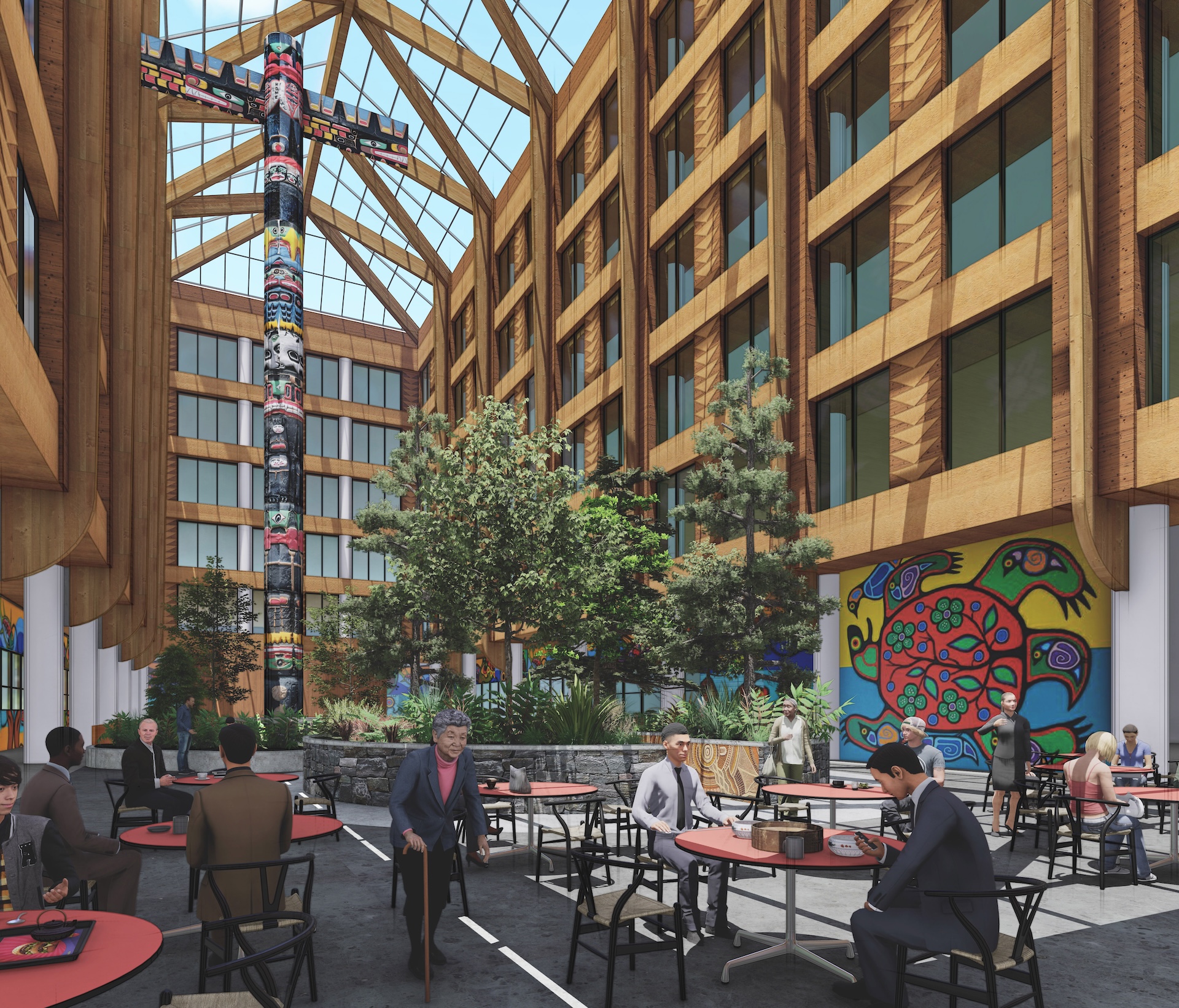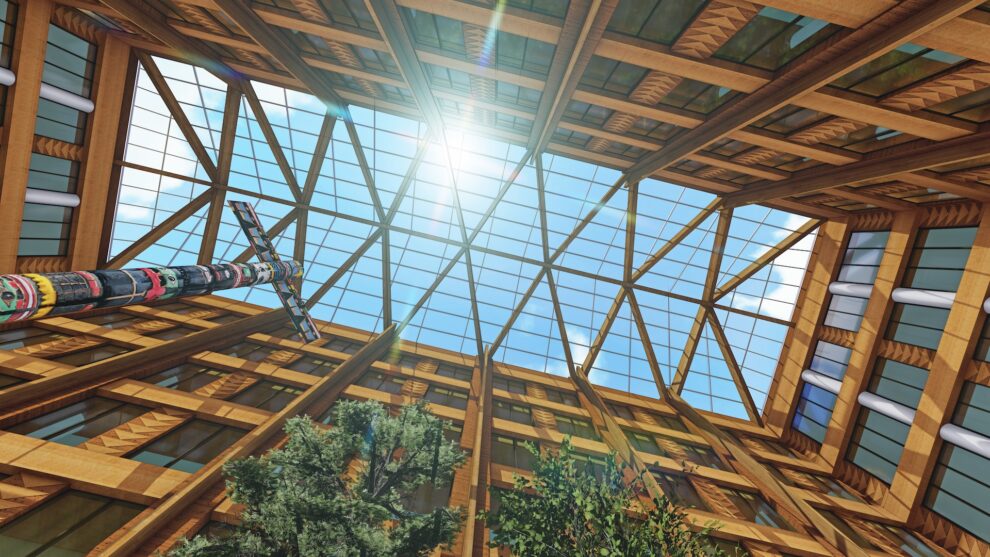New life is coming to the former Hudson’s Bay store in downtown Winnipeg.
The Southern Chiefs’ Organization (SCO) is leading the ground-breaking Wehwehneh Bahgahkinahgohn project — transforming the former Hudson’s Bay Company (HBC) heritage building into a multi-use facility that promotes social reconciliation and restores economic self-determination for First Nations people.
“The project is about correcting generations of exclusion, and the economic deficit that flowed from that exclusion, and ensuring that First Nations have equitable access to opportunities and also the ownership and decision-making power around those systems that help support economic prosperity,” says SCO’s grand chief Jerry Daniels.
After acquiring the building in 2023, SCO began bringing its vision to life, developing the site into a facility aimed at providing long-term economic, cultural and social prosperity for First Nations, while helping revitalize Winnipeg’s downtown core. The project, one of the largest of its kind in Canada, is a partnership between SCO and all three levels of government with an expected cost exceeding $300 million.
The design for the 655,000-square-foot building, led by Number TEN Architectural Group, includes approximately 370 affordable residential units, each offering either an exterior view or overlooking a spacious atrium lit with skylights and featuring artwork and designs by First Nations communities. The blueprints also include SCO offices, a daycare and restaurants on the main floor, as well as commercial office and retail spaces for lease that will prioritize First Nations businesses and entrepreneurs.

Creating employment for First Nations
Creating employment opportunities for First Nations people has been a priority for SCO, which represents 32 Anishinaabe and Dakota nations across southern Manitoba. SCO’s new Miikahnah Connect employment program gives First Nations trades professionals the opportunity to apply to work on the Wehwehneh Bahgahkinahgohn Project. As a result, SCO says First Nations employees have made up three-quarters of the 1,380 workers on the project and have clocked more than 145,000 hours of work since the project began.
Environmental sustainability and conservation are also being incorporated into the design to align with First Nations values.
“We have integrated First Nations’ design principals throughout, including natural materials, community connection and energy efficiency,” says Daniels. “This project includes energy-smart retrofits and a green rooftop that will reduce our environmental footprint by reducing energy consumption by 35 per cent and greenhouse gas emissions by 81 per cent. That aligns with First Nation values of treading lightly on our planet, on our Mother Earth.”
Providing economic sustainability
Economic sustainability is equally important, with the project designed to create and support employment and entrepreneurship both now and for future generations.
“The Southern Chiefs’ Organization has been very focused on vitality and creating better quality of life,” says Daniels. “We’ve been working to create long-term career paths in the trades working with Build Winnipeg and Build Manitoba. This development will build pride, prosperity and intergenerational wealth. It’s about restoring a place, purpose and power for First Nations right in the heart of the downtown core.”
Conserving as much as possible
As much of the original building architecture and materials as possible are being conserved, including the concrete and reinforcing steel removed from the ground floor, which was salvaged by a First Nations company that separates the steel for reuse and repurposes the concrete as granular fill.
“In a building like this, we use the word ‘deconstruction’ because you’re taking pieces or elements of it apart,” says Kelly Wallace, vice-president and Winnipeg district manager at PCL Construction, the contractor overseeing the project. “It is a structurally sound building so we are extremely mindful of how we disassemble it and are trying to recycle as much as we can.”
Wallace says the project has been a valuable learning experience and PCL is proud to be part of it.
“I am learning something new about First Nations culture every day working with the SCO team. It’s been an enlightening experience for me,” Wallace says. “Building strong economic and cultural relationships with First Nations in this province can be a real differentiator for Manitoba and this project has the potential to be a beacon for what is possible.”
A name with meaning
The name Wehwehneh Bahgahkinahgohn, meaning “it is visible” was chosen thoughtfully to highlight the critical role of the original people of Turtle Island in the fur trade—an important part of history that has been largely invisible in the Canadian narrative.
“The project sends a clear message that First Nations are drivers of growth, culture and innovation,” Daniels says. “We want to create vitality. We want to create a cultural shift in the mindset of not only our society broadly and within First Nations but really within our relationships with one another.” ■
A World-Changing Idea
In 2023, Fast Company magazine recognized the Wehwehneh Bahgahkinahgohn project as the “Best World-Changing Idea, North America”.
“That recognition reflects the transformative nature of what we’re doing,” says Daniels. “It’s not just for First Nations people but how Canada thinks about development, heritage and equity when it comes to the relationship with First Nations. It’s world-changing because it represents a shift from exclusion to leadership, from tokenism to true partnership and from past harms to future prosperity. We believe this project will inspire others across Turtle Island to re-imagine what reconciliation can truly look like. This is a blueprint for how economic reconciliation can be done right for major projects across Canada.”












